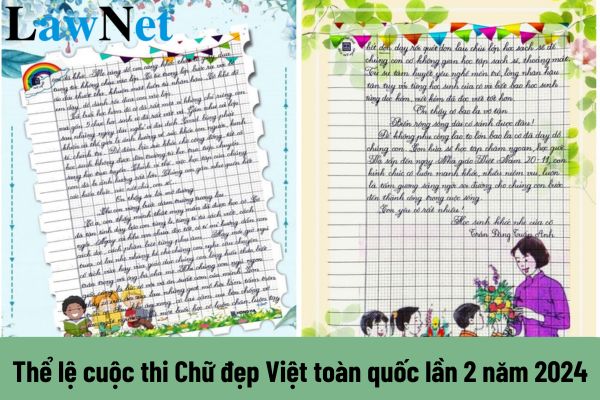What are regulations of the 2nd National Beautiful Vietnamese Handwriting Contest in 2024? How many mandatory subjects are there in the primary education curriculum in Vietnam?
Regulations of the 2nd National Beautiful Vietnamese Handwriting Contest in 2024
According to the announcement from the Organizing Committee, the regulations for the 2nd National Beautiful Vietnamese Handwriting Contest in 2024 with the theme "My Dream" are as follows:
|
Regulations of the 2nd National Beautiful Vietnamese Handwriting Contest in 2024
ELIGIBILITY: Students in primary school (grades 1 to 5) currently attending educational institutions in Vietnam.
FORMAT:
Each contestant will write a reflection, essay, etc., about their dream (not exceeding 1000 words) using Queen fountain pen ink. A valid contest entry will include a photo of the contestant writing their entry with Queen fountain pen ink (with the Queen ink bottle visible in the photo) and a photo of the completed written work.
Contestants must like the contest fanpage “Em Viet Uoc Mo” and the “Queen Van Phong Pham” fanpage; share their contest entry on their or their parents' personal page (in public mode, tagging the contest hashtags #emvietuocmo and #queenvanphongpham).
The written work can be on white paper, squared paper, or ruled paper. However, the Organizing Committee encourages contestants to use squared paper for the best handwriting outcome.
In this round, contestants using Queen fountain pens (FP17-1, FP17-2) will receive an additional 10 bonus points. The six contestants with the highest number of votes (calculated by likes and shares) will advance directly to Round 2 with 20 contestants who won in Round 1.
In the final round, to ensure fairness and consistency in handwriting, contestants will be required to use Queen fountain pens (models FP17-1, FP-17-2) and compete directly via the online software Zoomchat (Zoom). Additionally, each contestant must submit a contest photo according to the published email instructions.
Especially in Season 3 - 2024, all contestants will have the chance to submit a video of their handwriting using Queen fountain pen ink for the highly valuable Media Award of the contest.
COMPETITION ROUNDS:
ROUND 1: SHARING
(September 5, 2024 – December 5, 2024)
Contestants can submit one or multiple contest entries to the Organizing Committee (OC) via the registration form at ABC or scan the QR code in the attached image, fill in all required details, upload photos to complete the contest entry from September 5, 2024, to December 5, 2024.
(QR code photo)
Contest entry includes:
Contest photo:
+ Contestants must submit at least 02 (maximum 05) contest photos. The OC will select 2 - 3 best photos to post on the contest fanpage.
+ Among the sent photos, there must be at least 1 photo capturing the contestant while writing with Queen fountain pen ink (WITH QUEEN INK BOTTLE IN THE PHOTO) and at least 1 photo capturing (or scanning) the completed entry. Note: the contest photo must clearly show the content of the entry from an overhead angle. Entries with beautiful handwriting but unclear photos will also be deducted points by the OC.
+ For contestants using QUEEN FOUNTAIN PENS (FP17-1, FP17-2), please remember to take a photo of the contestant writing the entry with the pen and Queen ink; the contestant will receive a 10-point bonus in Round 1.
Contestant information:
+ Parents must provide all information: Full name, date of birth, current grade/school; contact phone number of mother (or father); email address, specific residential address according to the form.
The contest will divide into two contestant groups: Group of students in grades 1-2-3 and Group of students in grades 4-5, hereinafter referred to as groups.
Contest entries will be posted on the contest fanpage https://www.facebook.com/cuocthiemvietuocmo/. Viewers can vote directly on the fanpage for their favorite contestants to win the Most Voted Contestant award.
The 06 contestants with the most votes (03 contestants per group) will automatically advance to the next round along with 20 contestants (10 contestants per group) selected by the Judges, and results will be announced on December 5, 2024.
ROUND 2 - FINAL ROUND: DREAM
(December 15, 2024 – December 22, 2024)
In this round, 26 contestants will perform the test directly via Zoom (or similar software) at 9:30 a.m. on December 15, 2024. The test is to be completed within 90 minutes. At the end of the time, the contestant will present their work in front of the camera for the OC to capture the image of the recently completed test. Immediately afterward, the contestant will take a photo (or ask parents to help take a photo) of their test and send it promptly to the OC.
The contest results will be announced on December 22, 2024.
SCORING CRITERIA FOR GROUP OF STUDENTS GRADE 1-2-3:
The entry is scored on a scale of 100.
Includes:
+ Straight, neat handwriting: 10 points.
+ Correct font, correct size: 10 points.
+ Appropriate spacing between characters, between words and lines: 10 points.
+ Neat and clean presentation, no erasures, no smudges: 10 points.
+ Correct spelling: 20 points. Deduct 5 points for each spelling error.
+ Creative presentation with artistic value: 20 points.
+ Beautiful contest photo, meeting all the contest regulations, expressing the contestant's spirit during the test. Clear image, showing full content of the contest entry: 20 points.
+ Bonus points for using Queen fountain pen products (FP17-1, FP17-2): 10 points (applies only in Round 1).
SCORING CRITERIA FOR GROUP OF STUDENTS GRADE 4-5:
The entry is scored on a scale of 100.
Includes:
+ Straight, neat handwriting: 10 points.
+ Correct font, correct size: 10 points.
+ Appropriate spacing between characters, between words and lines: 10 points.
+ Creative presentation with artistic value: 20 points.
+ Beautiful contest photo, meeting all the contest regulations, expressing the contestant's spirit during the test. Clear image, showing full content of the contest entry: 20 points.
+ Content of the writing: 30 points.
+ Correct spelling: Deduct 5 points for each spelling error.
+ Bonus points for using Queen fountain pen products (FP17-1, FP17-2): 10 points (applies only in Round 1).
MEDIA ROUND
(September 5, 2024 – December 5, 2024)
All contestants participating in Round 1 of the "Em Viet Uoc Mo" handwriting contest have the opportunity to join the Media Round. Parents assist in recording the moments of the contestant writing their Round 1 entries, following the guidelines and suggestions from the OC, upload the video, and submit it according to the requirements to win the program's exciting prizes.
THE CONTEST PRIZES WILL BE ANNOUNCED ON DECEMBER 22, 2024.
Note: Contestants using other paper or pens, writing creatively not in accordance with Decision 31/2002/QD-BGD&DT are in violation of the rules.
|
Note: The information is for reference purposes only.

Regulations of the 2nd National Beautiful Vietnamese Handwriting Contest in 2024 (Image from the Internet)
How many mandatory subjects are there in the primary education curriculum in Vietnam?
According to Section 4 Appendix of the General Education Program issued together with Circular 32/2018/TT-BGDDT, the educational content at the primary level includes 10 compulsory subjects and 1 mandatory educational activity as follows:
- Compulsory subjects: Vietnamese; Mathematics; Ethics; Foreign Language 1 (in grades 3, 4, 5); Nature and Society (in grades 1, 2, 3); History and Geography (in grades 4, 5); Science (in grades 4, 5); Informatics and Technology (in grades 3, 4, 5); Physical Education; Arts (Music, Visual Arts);
- Mandatory educational activity: Experiential activity.
What is the general orientation for primary education methods in Vietnam?
According to Section 6 Appendix of the General Education Program issued together with Circular 32/2018/TT-BGDDT, the orientation for educational methods, and evaluation of educational results in the primary level general education program are as follows:
(1) Orientation for Educational Methods
The subjects and educational activities in schools apply methods that activate student engagement, where teachers play the role of organizing and guiding activities for students, creating a friendly learning environment and problem situations to encourage active participation in learning activities, self-discovery of their capabilities and aspirations, developing habits and self-learning abilities, and exploiting their potential and accumulated knowledge and skills for development.
Students' learning activities include problem exploration activities, practice activities, and application activities (applying learned knowledge to identify and solve real-world issues), carried out with the support of teaching devices, especially informatics tools and digital automation systems.
These learning activities are organized both inside and outside school premises through various forms such as learning theories; performing exercises, experiments, games, role-playing, research projects; participating in seminars, excursions, camping, reading; extracurricular activities, community service.
Depending on the objectives and nature of the activities, students are organized to work independently, in groups, or collectively as a class but must ensure that each student is provided opportunities to individually undertake learning tasks and experience reality.
(2) Orientation for Evaluating Educational Results
The goal of evaluating educational results is to provide accurate, timely, and valuable information on the extent to which program requirements are met and student progress to guide learning activities, adjust teaching activities, manage and develop the program, ensuring progress of each student and improving education quality.
The evaluation basis is the requirements related to qualities and competencies stipulated in the overall program and the subject and educational activity programs.
The evaluation scope includes compulsory subjects and educational activities, elective subjects and study topics, and optional subjects. The evaluation subjects are the products and the learning and training processes of students.
Educational results are assessed using both qualitative and quantitative methods through regular and periodic evaluations at educational institutions, broad-scale evaluations at national, local levels, and international assessments.
Along with results of compulsory subjects and educational activities, results of elective subjects and study topics, optional subjects are used to evaluate the overall learning outcomes of students within each school year and throughout the entire learning process.
The regular evaluation is organized by the subject teachers, combining evaluations by teachers, parents, the student being evaluated, and other students.
Periodic evaluations are conducted by educational institutions to manage teaching activities, ensure education quality at institutions, and serve program development.
Broad-scale evaluations at national, regional levels are organized by national or provincial testing organizations to manage teaching activities, ensure quality of education results at institutions, serve program development, and enhance education quality.
The assessment method ensures reliability, objectivity, suitability for each age, each education level, does not put pressure on students, and minimizes expenses for the state budget, students’ families, and society.
Gradually apply educational measurement and evaluation achievements from research, international experiences to improve the quality of evaluating educational results, classifying students at educational institutions, and using broad-scale evaluation results as a tool to control evaluation quality at schools.


